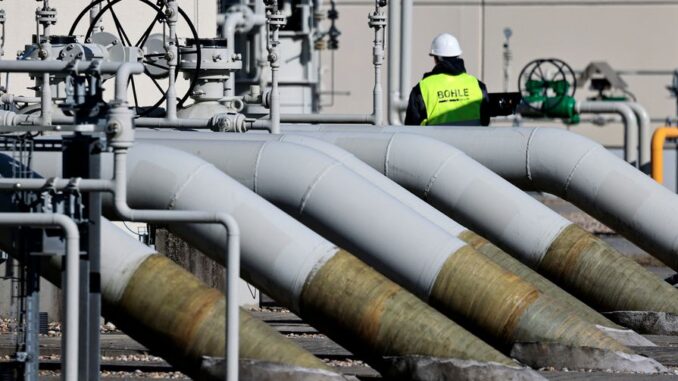
The nation’s capacity to refine crude oil into fuel and other products fell below 18 million b/d at the beginning of 2022 and hit its lowest level since 2014, according to the federal government’s annual refinery capacity report released June 21.
The US Energy Information Administration projects the nation’s operable crude refining capacity dipped to 17.94 million b/d as of Jan. 1, which is down from 18.09 million b/d at the beginning of 2021, and from the record high of 18.98 million b/d in 2020 before the pandemic took hold. The 2022 projection is the lowest since 17.92 million b/d in 2014, the EIA said.
The dip comes amid refinery closures in recent years and the recent surge in oil prices as retail gasoline and diesel costs hit record highs earlier this year. The new pricing records are coming from a combination of factors, including demand recovery from the pandemic and the ongoing war in Ukraine.
Some refineries have closed in recent years — or are slated for conversion — due to hurricane damages, pandemic impacts, high operations costs, the inability to complete sales, weaker future demand forecasts, or from conversions to produce more renewable fuels. The other fear is that a major storm hitting the US Gulf Coast could dramatically impact fuel supplies in an already tight marketplace.
The EIA report comes just two days before US Energy Secretary Jennifer Granholm is slated to meet with oil executives as the White House presses for increases in refining output and capacity to help meet demand and lower fuel prices.
Chevron CEO Mike Wirth wrote June 21 to President Joe Biden, noting that Chevron is doing what it can to produce more oil and fuels, but arguing that practical efforts are limited and that unrealistic political rhetoric should be avoided. He said the Biden administration often has “sought to criticize and, at times, vilify our industry.”
“In 2021, Chevron produced the highest volume of oil and gas in our 143-year history. In the first quarter of 2022, our US production was 1.2 million b/d, up 109,000 b/d from the same quarter a year earlier,” Wirth stated. “In the Permian Basin alone, we expect production to approach 750,000 b/d by the end of the year, an increase of more than 15% from 2021. And Chevron’s US refinery input grew to 915,000 b/d on average in the first quarter of this year from 881,000 in the same quarter last year.”
Chevron is one of the few companies to buy a refinery in recent years, scooping up the 112,229 b/d Pasadena Refinery in Texas from struggling Petrobras in 2019.
White House Press Secretary Karine Jean-Pierre said June 21 that the goal of the meeting with seven oil company CEOs is “to make sure that we have a sit-down conversation where we come up with solutions, that we work with the CEOs to figure out what else we can do to move that capacity forward.”
Biden, who will not participate in the meeting, said June 20 that he is considering a federal gasoline tax holiday, which would temporarily suspend the 18.4 cents/gal tax. A decision is expected by the end of the week.
The EIA’s estimate of 17.94 million b/d of operable refining capacity is a calendar day measurement of the amount of crude a refinery can process under usual operating conditions and is the typical metric used in measuring refinery capacity. However, the report estimates 154,800 b/d of average idle time, which would bring operable capacity down to about 17.79 million b/d.
The other refining capacity measurement the EIA uses is operable barrels per stream day, which represents the refinery ideal. It is the amount of crude any given refinery can process in a 24-hour period, running full out with no downtime and operating under optimal conditions for both crude and refined products. The EIA projects the US at 18.95 million b/d of operable barrels per stream day for 2022.
Refinery closures
North America has lost close to 1.3 million b/d in refining capacity in the last three years, including more than 600,000 b/d in Louisiana, although there have been some modest capacity expansions, such as at ExxonMobil’s Baton Rouge Refinery. ExxonMobil is one of the few companies in the US that is investing in refining, with a 250,000 b/d expansion underway at its Beaumont refinery in Texas that is equal to a new refinery. But the pandemic delayed the completion of that project at least until 2023.
Within Louisiana, the 255,600 b/d Phillips 66 Alliance Refinery, the 211,146 b/d Shell Convent Refinery and the 135,500 b/d Calcasieu Refining complex have all closed since the beginning of 2020 because of a myriad of factors, including hurricane impacts.
And more closures are on the way elsewhere. By the end of 2023, petrochemical producer LyondellBasell said it plans to shutter its only oil refinery — the 263,776 b/d Houston Refinery in Texas — to make space for other potential projects.
In California, the focus is on converting traditional oil refineries into renewable fuels units.
In 2020, Phillips 66 announced plans to turn its 120,200 b/d Rodeo refinery in California into the world’s largest renewables fuel project, replacing crude with organic feedstock like cooking oil, fats, greases and soybean oils to make renewable diesel, renewable gasoline and jet fuel.
It will also permanently shut its 44,500 b/d Santa Maria, California, refinery, which traditionally supplied intermediates to Rodeo for final processing.
Marathon Petroleum will turn its 161,000 b/d Martinez, California, oil refinery into a renewable diesel plant. The plant was shuttered in April 2020, along with its 26,000 b/d Gallup, New Mexico, plant, which will not reopen as a refinery.
Source: Spglobal.com


